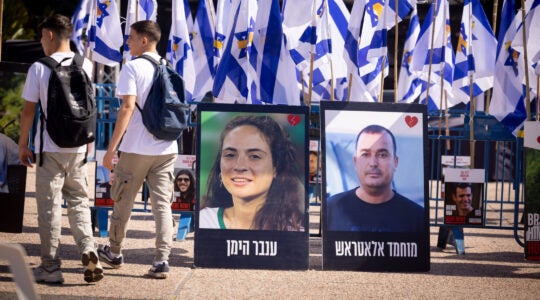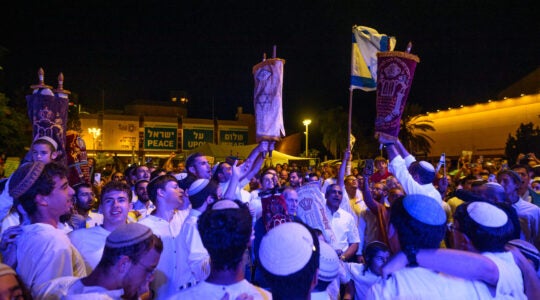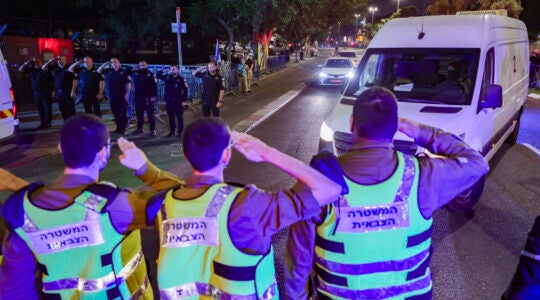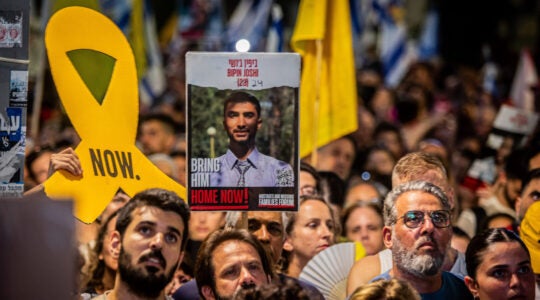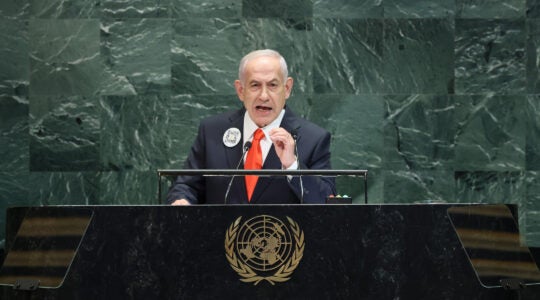Driving the northernmost spur of Israel’s Road 886, it’s hard not be astonished by just how close Israelis and their Hezbollah foes lived to one another before the war that began 14 months ago.
In the panhandle known as the Finger of the Galilee, Road 886 runs south-to-north along the Ramim Ridge, a 3,000-foot-high range in the Naftali Mountains dotted with small Israeli towns and kibbutzim that overlook Israel’s lush Hula Valley to the east and a smattering of Lebanese villages to the west. The road terminates at Misgav Am, a storied Israeli kibbutz right on the border fence that’s closer to the Lebanese village of Udaysah than to any town in Israel.
When I drove the length of this road several days after the announcement of Israel’s ceasefire with Hezbollah — and shortly before Israeli troops entered nearby Syria after the fall of the government there — signs of war were everywhere.
At one clearing in the woods, spent artillery canisters and detritus left behind by soldiers were scattered on the ground. Trees scorched from fires sparked by incendiary exchanges between the two sides were bent at odd angles. The road, chewed up by tanks and heavy military equipment, is full of large potholes and tread marks. Concrete berms stand at points where the military fashioned makeshift routes into Lebanon. A roadside picnic area is a mess of mud, the vestige of a staging ground for military vehicles.
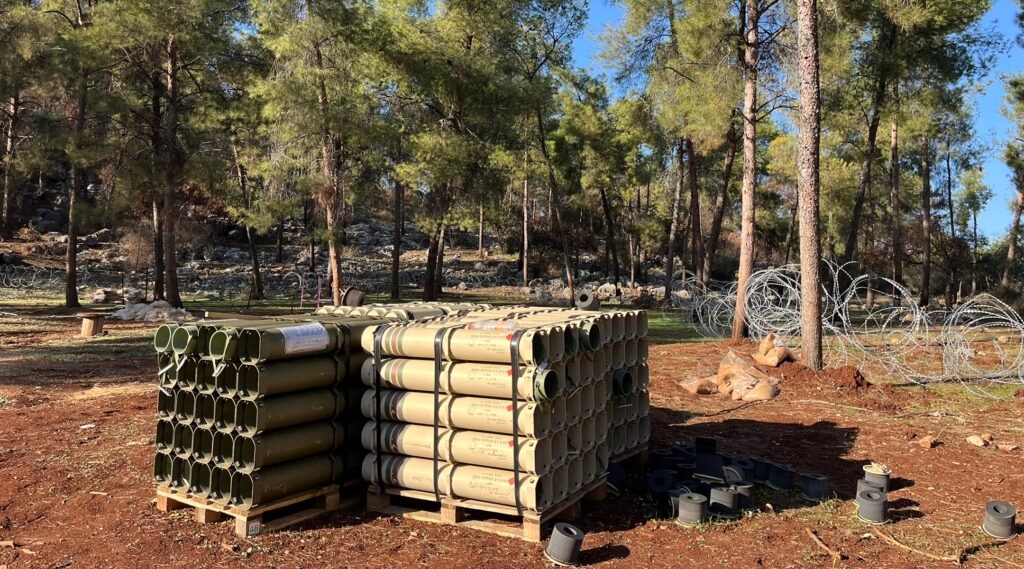
Spent Israeli artillery shells in the forest are part of the detritus left behind after the war. (Uriel Heilman)
At Kibbutz Manara, where in better times tourists can ride a gondola down the steep ridge to a base station just outside the Israeli city of Kiryat Shmona, Road 886 is flush with the border. The kibbutz is so close to Lebanon that a Hezbollah fighter could theoretically hear an Israeli baby in Manara crying in their bedroom crib less than 100 yards away.
When I stopped to take some photos, I heard a U.N. vehicle turn on its ignition at a UNIFIL post on the Lebanese side of the fence.
The only reason I didn’t feel like I was risking my life was because there were still Israeli soldiers on the Lebanese side. Under the terms of the current ceasefire, Israel has 60 days to move its troops out of the country. The Lebanese villages near the border remain unoccupied and, in many cases, largely in ruins, and the Israeli Defense Forces has warned Lebanese residents that they cannot yet return.
There is no such order in place for Israelis, who for the first time in more than a year can return to their homes in the northern Galilee without the threat of imminent attack from Hezbollah drones and unmanned aerial vehicles (UAVs), rockets, antitank fire or infiltrations.
But the Israelis who live here for the most part haven’t come back.
“There’s lots of things people don’t know,” Shani Atsmon of Kiryat Shmona said of Hezbollah. Atsmon has been living at a hotel and hasn’t yet returned to the city. “At any second they can come into Israel with paragliders like Hamas did on Oct. 7. Maybe there are tunnels. They’re still at the fences. I don’t want to risk my life. It can come from anywhere — Lebanon or Syria. It’s scary.”
Unlike in southern Lebanon, where roads were jammed with returning residents almost as soon as the ceasefire was announced on Nov. 27, the northern Israeli communities that emptied out due to the war are still ghost towns. There are no schools open, banks are mostly closed, health clinics aren’t operating, and there’s hardly any place to buy food. The government is still paying for evacuees to live elsewhere, and many families with children already have made clear they won’t move back until the end of the school year in six months, at the earliest.
The fall of the Assad regime this month in Syria only adds to the uncertainty. While the Israeli military has conducted an extensive bombing campaign to degrade the offensive capabilities of any future Syrian army, the turmoil in Syria and the fall of Damascus to an Islamist militia is a reminder that threats to the border region of northern Israel are never far away.
“We still don’t have a feeling of security,” said Revital Gabay, a nurse who evacuated from Kiryat Shmona and is living at a hotel outside the city. “I was home on Friday for five minutes to get something and I heard army artillery fire. We know Hezbollah is on the other side of the fence, watching us. We’ll have another two years of quiet and then at some point there’ll be a war and we’ll be sent back to the stone age.”
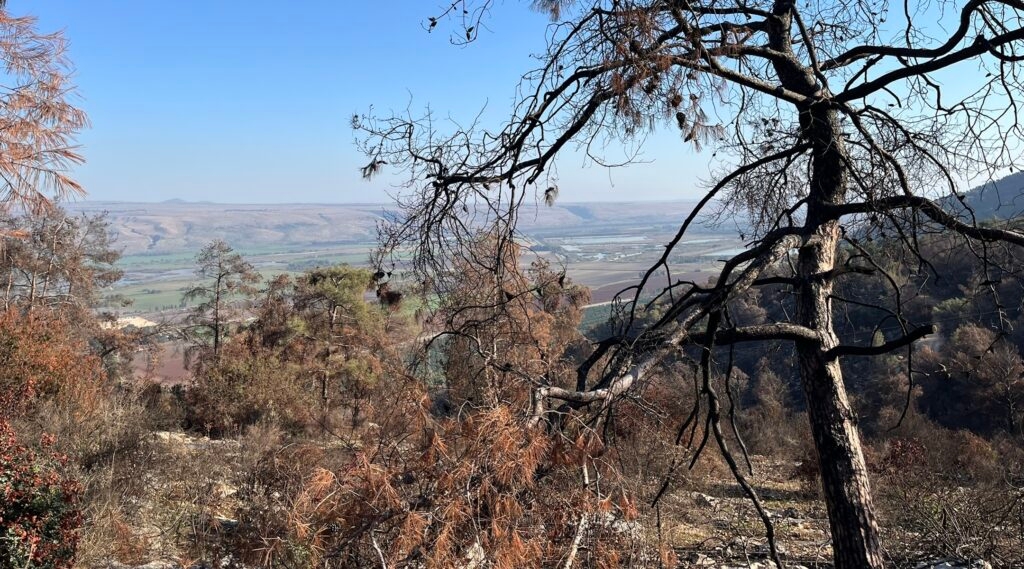
There are many burnt patches of forest on the Ramim Ridge overlooking Israel’s Hula Valley. (Uriel Heilman)
The question that will determine northern Israel’s future
I went to Israel’s northern war zone because I wanted to see what it looks like in this liminal period between the apparent end of the long war with Hezbollah and the resumption of normal life. What I found was that while certain frontline communities, such as Metula, have suffered extensive destruction, the area’s main city, Kiryat Shmona, and many surrounding towns and kibbutzim have limited damage.
To be sure, there are wrecked homes to rebuild, burnt forests to restore, crumbling businesses to reconstruct and ruined roads to repair. Israeli government authorities estimate direct damage to Israel’s 82 border-area communities — those in the 4.5-kilometer evacuation zone near the Lebanon border — at over $420 million, including damage to homes, public and private buildings, infrastructure like electricity and water, agriculture, equipment and vehicles. Along with indirect losses, such as compensation for lost revenue — if, for example, a farm couldn’t produce the pomegranates it normally does — the total costs of the war in the north are an estimated $1.4 billion, excluding military expenditures.
And over 110 soldiers and civilians inside Israel were killed by Hezbollah attacks since Oct. 8, 2023, when the Lebanese terrorist group joined in attacking Israel the day following Hamas’s shocking, brutal attack in the south.
But considering the intensity and duration of the attacks here, the area fared much better in the showdown with Hezbollah than military analysts had predicted — a testament to the effectiveness of Israel’s overwhelming military successes in Lebanon in addition to its homefront defenses like the Iron Dome anti-missile system, air raid alerts, abundant bomb shelters, and, somewhat controversially, the decision to evacuate over 60,000 locals.
The more lasting damage up north, it seems, is psychological — with even graver long-term implications for the future of the Galilee than the war’s physical toll.
More than anything else, residents are traumatized by the fear that what happened in southern Israel on Oct. 7 can happen here, too — if not in the near future then one day years from now, when their children will pay the price.
“We lived here with quiet for 20 years, but we never forgot that they hate us,” Kiryat Shmona resident Zahava Zarad, 61, said of her Hezbollah neighbors across the border in Lebanon. “I want the army to kill Hezbollah without giving them any advance warning. Their little kids today are the terrorists who one day will come to murder my grandchildren. They have to be destroyed in groups, not one by one. That’s the feeling.”
The critical question for Israel is whether the security concerns of those who live here can be assuaged. If not, the northern Galilee will struggle to retain its population, much less attract newcomers, and the area may fall into a downward spiral as families leave, businesses fail and real estate prices crater.
If that happens, the damage from Oct. 7 will last for generations.
“Only those who really love it here will return — or those who have no alternative,” Zarad said.
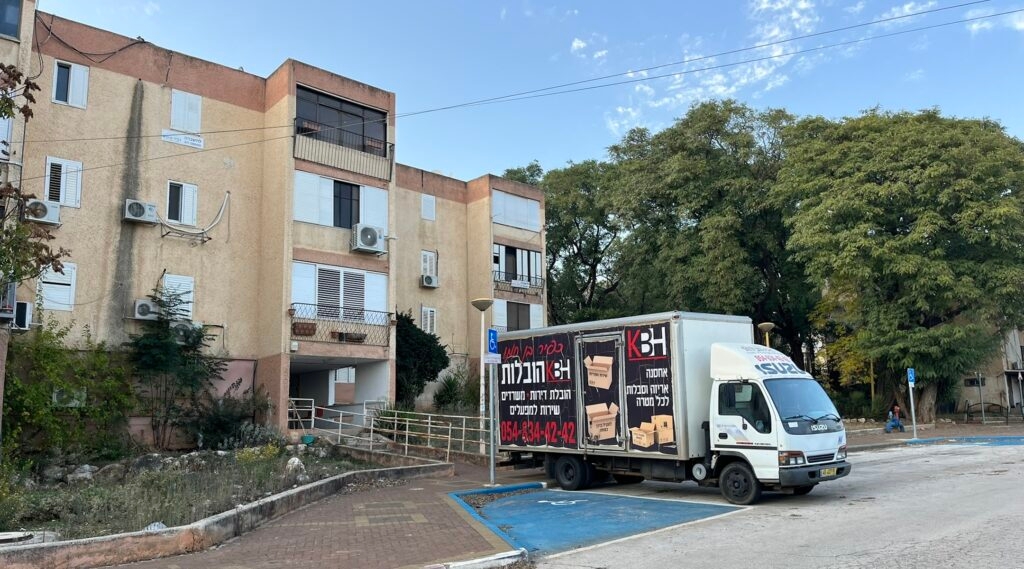
A moving truck is one of the few vehicles in this neighborhood in Kiryat Shmona. (Uriel Heilman)
Ramim Ridge: In the line of fire
Bordered by Lebanon both to the west and north, the Finger of the Galilee is particularly vulnerable to enemy attack.
During the war, Hezbollah used rockets and UAVs to attack Israeli targets as far away as metropolitan Tel Aviv, but closer Israeli communities presented the most convenient target of opportunity. The communities here could be reached using short-range rockets, artillery, and a uniquely nimble and lethal weapon against which Israel struggled to defend: antitank shells.
Unlike rockets, which fly in an arc and can be intercepted by Israel’s Iron Dome system, antitank shells fly straight as a bullet, can be shot using shoulder-mounted systems, often arrive without warning, and can tear through the Israeli safe room shelters known as mamads like they’re a tin can. That meant that any Israeli community with a straight line of sight into Lebanon and within the range of antitank fire — about two to three miles — could be a very dangerous place.
This is partly why Israel’s evacuation order was set to cover any community within 4.5 kilometers (about 2.7 miles) of the border.
The communities that sit atop the Ramim Ridge, some abutting the border, were particularly exposed.
At Ramot Naftali, a picturesque town on the ridge that in normal times is home to about 550 residents, vintner Yitzak Cohen, 75, is one of the few locals who stayed home throughout the war. He owns a boutique winery that produces about 15,000 bottles per year and grows his grapes on a four-acre plot of land in the Kedesh Valley on the west side of the ridge, in full view of the Lebanese villages about two miles away.
“I was born here. I experienced all the wars that were here. This was a very strange war, very atypical,” said Cohen, whose house is right behind the facility where the wine is aged and bottled. “This thing of evacuating all the residents was extreme. I didn’t consent to be evacuated.”
Ramot Naftaly Winery stayed operational throughout the war, thanks to a skeleton crew of Israelis and Thai laborers. They kept working amid sirens, Hezbollah attacks and a seemingly endless rain of shrapnel.
“Every morning you’d find shrapnel here,” Cohen said. “But it didn’t deter us. We kept going.”
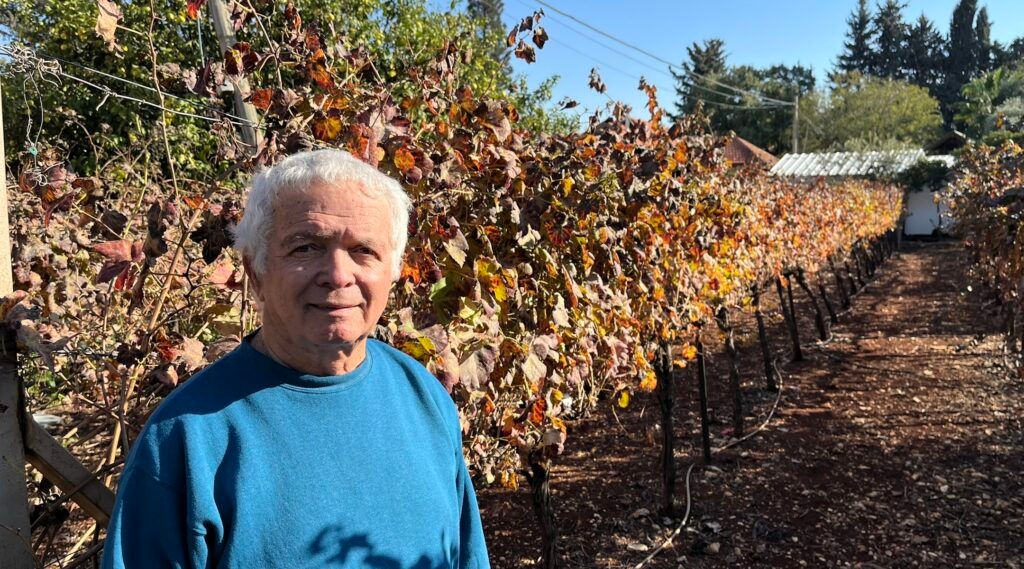
Vintner Yitzhak Cohen stayed at his Ramot Naftali home for the duration of the war even as almost everyone else evacuated. (Uriel Heilman)
The winery’s visitor center, a significant source of income with group tastings and gourmet meals and special events, was shuttered. The first group to return after the war arrived the day before I visited.
“For the time being it’s pretty sad here. I’m waiting for residents to return to the town,” Cohen said. “Now you see on weekends that families with children are coming back to scout out the situation.”
But the families aren’t staying. Cohen can’t even get his grandchildren to visit. That morning, Cohen told me, he had an intense argument on the phone with his son-in-law, who doesn’t feel comfortable having his children visit their grandfather on the front line. The kids, by Cohen’s account, are eager to come.
He sighs. Cohen’s wife split her time during the war between Raanana, where a daughter lives, and home, where she’d spend the weekends with her husband. But over the last year, Cohen has seen his grandkids only about once a month — relatively infrequent by Israeli standards.
Cohen walks me back behind the winery and shows me the chicken coop beside his house where his grandkids gather eggs whenever they visit. Without his family around, the chickens produce more eggs than Cohen can possibly eat; he gives away the excess to neighbors. Cohen reaches over to the persimmon tree behind me, plucks one of the bright orange orbs, wipes it against his shirt and takes a bite, beckoning me to do the same.
“I see it as a mistake that the government evacuated the residents. I’m not saying that someone who is afraid, who has kids, should be prevented from leaving, but for it to be initiated by the government was a terrible mistake,” Cohen said. “If the towns here had been full, then they” — meaning Hezbollah — “wouldn’t have dared to do what they did when there were no residents. If they would have hit one family, we would have erased them. They would have been afraid.”
In the 2006 war with Hezbollah, Cohen recalls, a Katyusha rocket landed in his yard while his daughters were in the house. It’s not clear whether this anecdote buttresses his argument.
I ask Cohen the question on everyone’s minds: When will his neighbors return?
“It depends on the circumstances, on how people feel about their personal safety, their financial security,” he says.
Outside Kibbutz Yiftah, another community on Ramim Ridge about two miles from Lebanon, I come upon a man with his three adult children harvesting olives alongside the road.
Early December is generally late to pick olives, which are practically ready to fall off the tree on their own. But Arik Aharon and his children, all of whom live in Yiftah during normal times, are just in time. Aharon’s two sons and daughter have spread out a long net to catch the fruit, which they shake off the tree using a mechanical picker that resembles a pitchfork with moving fingers. The olives will have to be pressed immediately; during the harvesting season, an olive press may stay open throughout the night to process a freshly picked yield. The Aharons will probably get just a few kilograms of olive oil this year from their rushed labor.
But it’s better than nothing. Last year the trees went unpicked, Arik tells me. He, his children and their families all evacuated to points south.
“We haven’t returned home,” says Or, his daughter. “It’s not possible to go back now and live in Yiftah. But it is possible to harvest olives.”
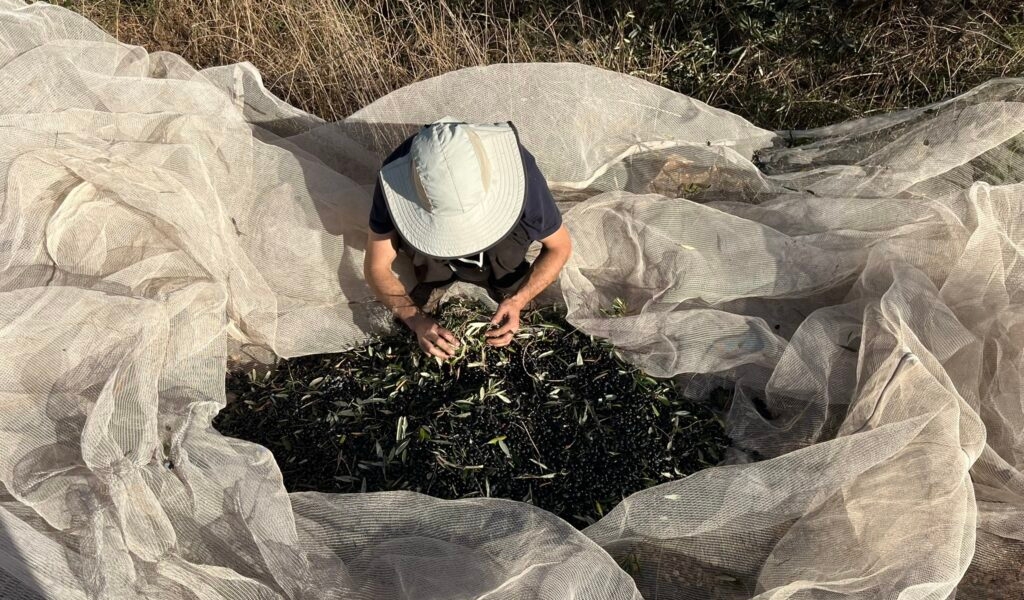
The Aharon family from Yiftah came to harvest olives just outside their borderline kibbutz, Dec. 3, 2024. (Uriel Heilman)
When will they come back?
“I don’t feel safe returning now; it’s not on the agenda,” Or says. “I have a baby daughter. We’re 1,000 meters from the border. I won’t come back until I feel safe.”
What will make you feel safe? I ask.
“I don’t have an answer,” she replies.
Kiryat Shmona: A city without people
When I arrive at Kiryat Shmona in the early afternoon, I pull into the shopping center at the city’s southern entrance to grab a quick bite. The parking lot is surrounded by Israeli and international chain restaurants: McDonalds, Pizza Hut, Café Neeman, Biga boulangerie.
But as I step out of my car it becomes clear they’re all closed. Of course, I realize. For 14 months they’ve been gathering dust, their customers and employees gone. Reopening will be more complicated than flicking on a switch and lighting the ovens. Equipment needs to be cleaned, damage repaired, employees hired. Most important, there must be customers.
The only action at this shopping area is at the supermarket, which stayed open throughout the war. Many of its patrons carry automatic weapons. They’re either soldiers in uniform or members of local security squads who stayed here for the duration of the war, paid by the government to safeguard their own communities.
I head into town and park on Kiryat Shmona’s main drag. The last time I visited this particular strip, in early April, the only eatery still operating was a family-owned shwarma place called Baguette Shlomi that had stayed open to serve soldiers deployed to the area and a few remaining locals. While interviewing one of the restaurant’s owners we were interrupted by an air raid siren and had to rush into the kitchen for cover.
This time, I see a long line of customers snaking out the door, despite the fact that it’s mid-afternoon. Baguette Shlomi is the only place open among a dozen or so stores on the block. Next door, a mobile phone shop has a sign taped to the door that reads, “Dear soldiers! Please wipe your boots of mud before entering the store!”
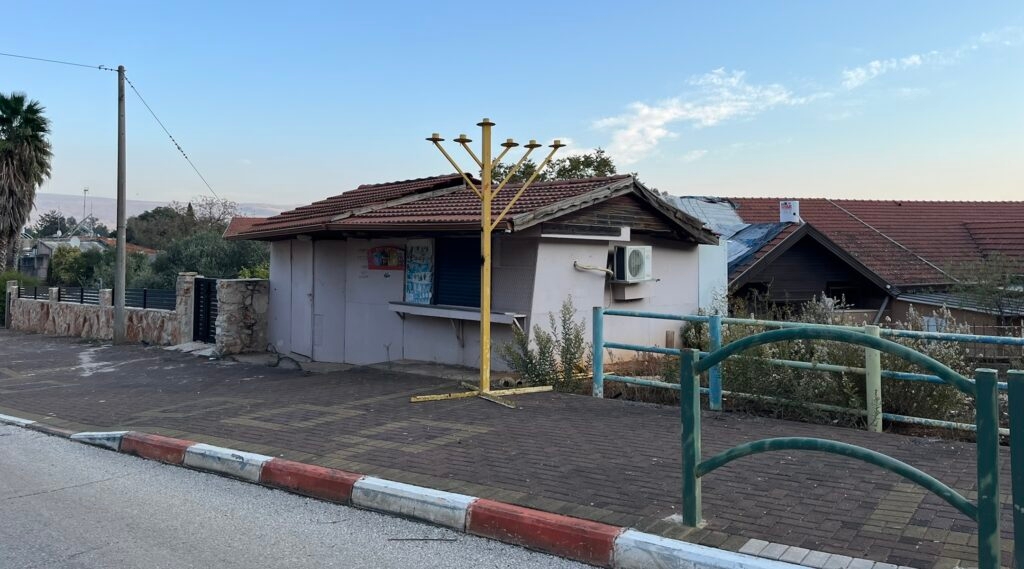
A Hanukkiyah missing several branches is a sign of dereliction in Kiryat Shmona. (Uriel Heilman)
Kiryat Shmona is a city in need of some TLC. At one roundabout, a rusting 7-foot menorah from some bygone Hanukkah that’s missing three of its eight branches is perched on the sidewalk, a sad-looking sentry in a mostly empty neighborhood. At night, the windows in large apartment blocks are mostly dark, their occupants living elsewhere.
Ravit Levi, who spent about a year at a hotel 15 minutes south of the city, went back to her Kiryat Shmona home in early November. Even though the war was still raging, the IDF’s invasion of southern Lebanon gave her confidence to move back — that, and she was fed up living in temporary accommodations.
“We said, That’s it. We were tired. We missed home,” she said. “Now we’re in our home and it’s a pleasure for us.”
Her adult daughter, Peleg Levi, a single mom with two kids, also returned to Kiryat Shmona. Because there are no schools open in the city, her 11-year-old son must commute about 10 miles south to attend school at Yesod Hamaala. During the war, if there was too much shelling or if Peleg didn’t feel comfortable doing the drive, she kept her son home.
Meanwhile, her 2-year-old daughter has returned to a house she doesn’t even remember, according to Peleg. “She’s more used to growing up in a hotel surrounded by strangers,” Peleg said.
It’s not easy finding people in Kiryat Shmona, which had a prewar population of 25,000. I drive for blocks on end without seeing a soul.
In the relatively new neighborhood of Yuvalim, a bus careens through the streets but there are no passengers at any of the stops. One block bears the scars of a direct strike: The impact crater on the pavement has been filled in by dirt, nearby apartment buildings are pocked with shrapnel damage, and the windows of the closest building were all blown out and are covered with plywood. There’s broken glass in the lobby, the elevator isn’t working because there’s no electricity and the stairwell is covered with guano from birds that found their way inside.
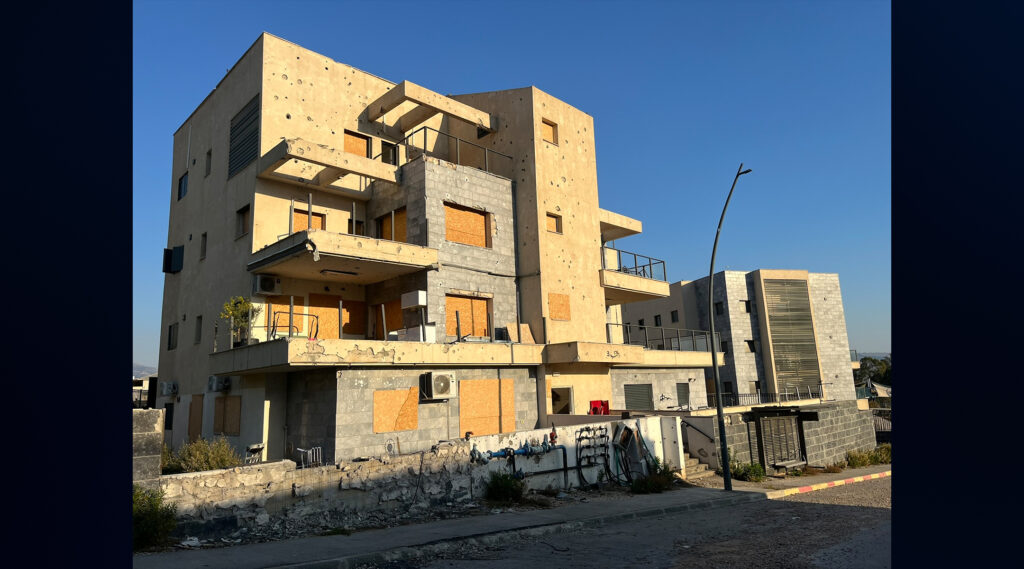
This apartment building bears scars from a wartime strike on the road in front of the building. (Uriel Heilman)
Elsewhere in the neighborhood, the frame of a sukkah is visible on an apartment balcony, its walls torn to shreds and its roof long gone. It’s an eerie reminder of the day this long war started, with a surprise early morning attack the day after Sukkot’s conclusion, on Simchat Torah, prompting many residents to flee in their pajamas — to say nothing of dismantling their sukkahs. I’m reminded of the forlorn sukkahs I saw still standing amid the ruins in Beeri, Sderot and other southern communities months after Hamas’s Oct. 7 attack.
In the hillside neighborhood of Naftali Hills, which overlooks the entire city, I run into David Cohen and two of his daughters cleaning the patio in front of a small synagogue. Cohen, 56, was born and raised in Kiryat Shmona, and his eight children were born here. He spent most of the war in Tzfat and is eager to return, but it’s not possible yet because the schools aren’t open.
In any case, the family isn’t quite ready. Cohen’s youngest daughter, Adi, is worried about a terrorist coming through her window, Cohen says. Their neighborhood is the closest one in Kiryat Shmona to the Lebanon border, and there are no other towns in between.

This Kiryat Shmona sukkah destroyed by the elements is a reminder of the day the war began in Oct. 2023, just after the holiday of Sukkot. (Uriel Heilman)
Cohen says he’s not sure whether the ceasefire will hold up, but in the meantime he’s taking advantage of the quiet to clean up. His yard is overgrown and neglected, his fridge shorted out and broke due to war-related electrical blackouts, and there’s dust everywhere in the house. Other homes have been infested by rats — a story I hear repeatedly during my trip.
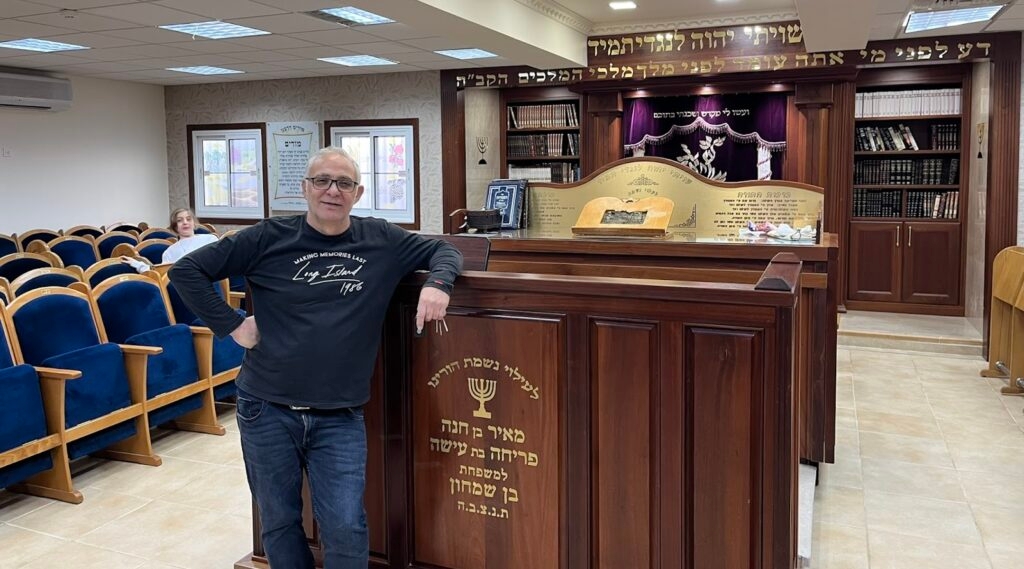
Even though there aren’t enough men in his Kiryat Shmona neighborhood for a minyan, David Cohen makes sure that the Mishkan Saadya synagogue, where he is gabbai, is clean and ready. (Uriel Heilman)
He takes me into the synagogue to show me some damage to the interior ceiling of the social hall where some shrapnel hit the roof, but the sanctuary, after a thorough cleaning, looks pristine. Cohen is the gabbai (sexton) of the synagogue, Mishkan Saadya, which he was instrumental in building and which carries his grandfather’s name. Before the war, as many as 100 people would come to Friday night services. Now, Cohen says, he doesn’t think there are more than five men living in the neighborhood.
“A synagogue that goes 14 months without a minyan is sad. To see it abandoned like this …” his voice trails off.
Kibbutz Kfar Blum: Just outside the evacuation zone
During this war, even small distances could make a big difference. Kibbutz Kfar Blum was one of the unfortunate communities in the lose-lose zone: too far for residents to be eligible for government assistance to relocate elsewhere, but close enough to Lebanon to make for an opportune target for Hezbollah.
Most Kfar Blum residents had no choice but to stay, even as nearby communities to the north emptied out and services like schools, health clinics and shopping areas shut down.
A week into the ceasefire, Kfar Blum appeared idyllic. Retirees balancing on antiquated bikes cycled on the kibbutz paths. A shirtless young man sat in the sun writing a song on a yellow notepad. Laughing children could be heard through the open window of a neighborhood preschool. Everywhere, the boughs of citrus trees hung low with ripening lemons, grapefruits, oranges and pomelos. Some of the deciduous trees were at peak foliage, flaunting brilliant yellows and reds.
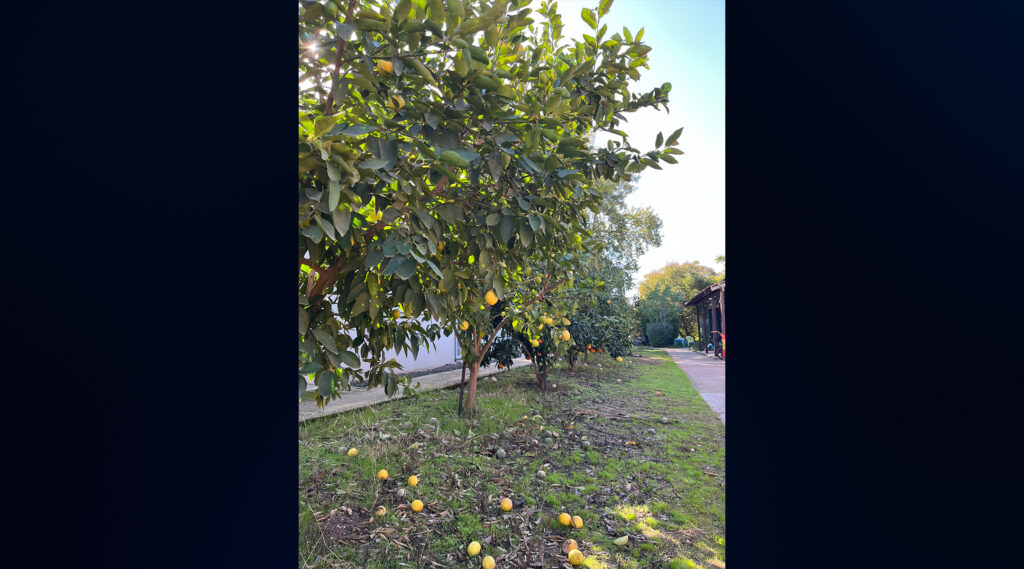
The citrus trees in Kfar Blum are heavy with ripe fruit. (Uriel Heilman)
But scars of war were also evident. A soldier sitting behind a concrete bunker manned a checkpoint at the entrance to the kibbutz, checking every vehicle seeking to enter. On Nov. 24, the Pastoral Kfar Blum Hotel, a luxury lodge whose rooms are rarely priced under $300 per night, took a direct hit, leaving the roof of one of the guesthouses mangled, and a 60-year-old man was seriously wounded. The many bomb shelters in the kibbutz are still unlocked and ready.
“It was scary,” said Zvi Renan, 70, a bus driver who last month moved to a rental unit at Kfar Blum from Beit Hillel, a town about three miles north, in the evacuation zone. “When the drone attacks began, it became clear very quickly that they can kill or wound you. It’s not a pleasant feeling. On one drive to Kiryat Shmona I had to stop and run for cover three separate times.”
Despite the evacuation of Beit Hillel, Renan decided to stay put. But between all the sounds of war, Renan said, he didn’t sleep soundly even for a single night. Sometimes he failed to make it to shelter in time when an air raid siren sounded. The stress took a toll. Three and a half months ago, Renan had a heart attack. He’s now recovering from surgery.
Despite the challenges, Renan has no intention of leaving.
“I moved to the north four years ago and I’m sorry I didn’t come 30 years sooner,” he said. “I own an apartment in Givatayim” — next to Tel Aviv — “but I’ll never move back to the center of the country. I can’t take the crowds and the stress.
“I didn’t regret moving up north even for one second during the war. On the contrary, we have to stick our finger in the eyes of Hezbollah and the Iranians and show them that people here won’t move. I’m one of those who believe that it was a mistake to evacuate the north when Hezbollah started firing at us. We should have gone into Lebanon the next day.”
Renan ignored his daughters’ pleas to leave. If he died, he told them, the two properties he owns would ensure they’d be okay financially.
“When I hear people in Israel say it’s difficult, and they want to move to Cyprus or Greece, it makes me want to vomit on them,” Renan said. “We have no other home. My mother spent five years in a concentration camp in Europe. Even if you’re in the shit here, at least it’s your shit.”
Then he reached up into his avocado tree and offered me two bright-green fruits to take home to my family.
The evacuees: Not hurrying to come back
The Yarden Boutique Hotel is so close to Kiryat Shmona, about 15 minutes south, that I was surprised to find it full of displaced residents from the city. Out of 130 rooms, about 115 are occupied by evacuees, according to hotel CEO Meir Levi.
It turns out most chose this location because they or their spouse need to be near Kiryat Shmona for work. The evacuees here include local policemen, men who work at essential factories related to the defense industry, and lots of agricultural workers — including about 70 foreign laborers.
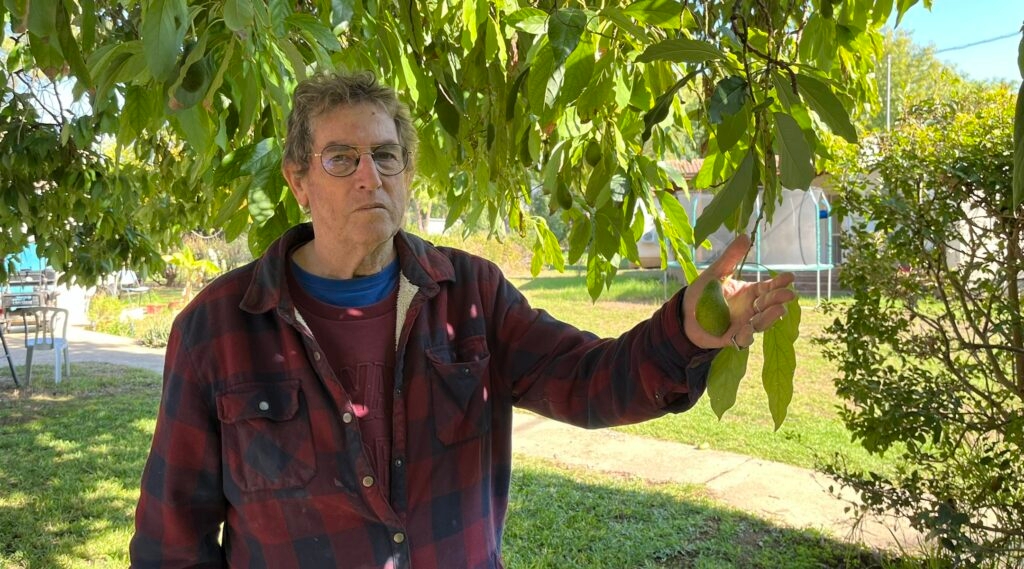
Zvi Renan, now a resident of Kfar Blum, moved to northern Israel four years ago and says he’ll never leave. (Uriel Heilman)
A few weeks ago, four Thai workers who’d been living at the hotel were killed in an Oct. 31 barrage by Hezbollah on an apple orchard in Metula, about 100 meters from the border, that also killed an Israeli farmer.
Before the war, said evacuee Miri Ben Shaanan, there was practically no social interaction between the Thai workers and the local Israelis. But with everyone living together at the hotel, a sense of comradeship had taken hold. “We talk with them, we laugh with them,” she observed. “This never was the case before.”
After more than a year in the hotel, the evacuees seem to be at wit’s end. Tired of eating the hotel’s food, many have turned their rooms into makeshift kitchens, acquiring microwaves, refrigerators, electric burners, and toasters so they can prepare food that makes them feel at home. Some evacuees have bought washing machines.
Shani Atsmon, whose husband works for the police in Kiryat Shmona, says living in the hotel has felt like an eternity. She has marked two of her husband’s birthdays at the hotel, and other families have celebrated weddings and bar mitzvahs there. Babies learned to walk in the lobby. Parents have sent off their kids to the army from the hotel.
“My daughter was drafted into the army last week. When she comes ‘home’ we can’t cook for her or do her laundry like a normal person,” lamented Gabay, the Kiryat Shmona nurse, who lives at the hotel.
“My 6-year-old is afraid to go to bed at night,” she said. “If we had an alternative we wouldn’t stay here in the north. Enough! We’re fed up being the country’s shield. But we can’t afford to live in the center of the country. If we could, I don’t think I’d stay.”
Some of the family’s close friends are returning, Gabay said, but others are putting up their homes for sale. Families that found a place for themselves in the center of Israel — where culture, excellent healthcare and job opportunities are in abundance — won’t return, she said.
“Kiryat Shmona always struggled, but we felt the place was starting to develop,” Gabay said. “Now it will take time to go back to what it was. You feel like it’s starting from zero.”
During breakfast at the hotel, I sit with Etti and David Fahima. She’s ready to return to Kiryat Shmona, but he says it’s not safe.
“I very much want to go back to my home, my things,” Etti says. “Being here so long has crossed the bounds of good taste. I live in this hotel in a state of chaos. I’ve worked from my hotel room for a year.”
David says they’ll stay at the hotel for as long as they can because it’s safer than going home. Sooner or later, he understands, the government will stop underwriting their stay. No one knows when that will happen, but the rumored date everyone keeps mentioning is Feb. 1.
“The moment the government turns off the flow of aid we won’t have a choice but to go back,” David said.
“But people have internalized the fears of Oct. 7. When you don’t have a feeling of security, you have nothing.”
JTA has documented Jewish history in real-time for over a century. Keep our journalism strong by joining us in supporting independent, award-winning reporting.

